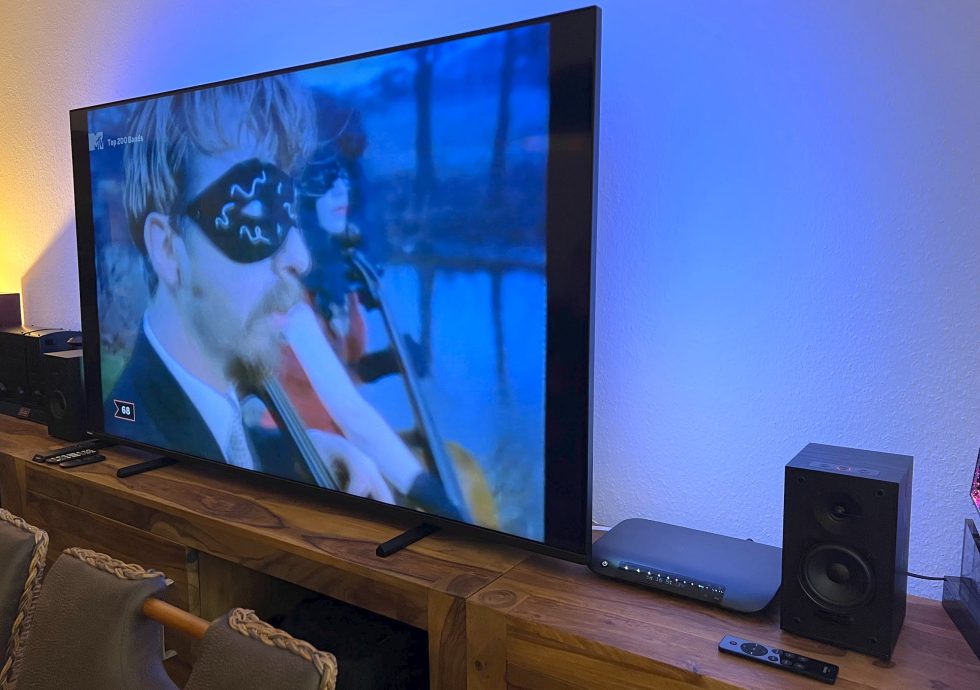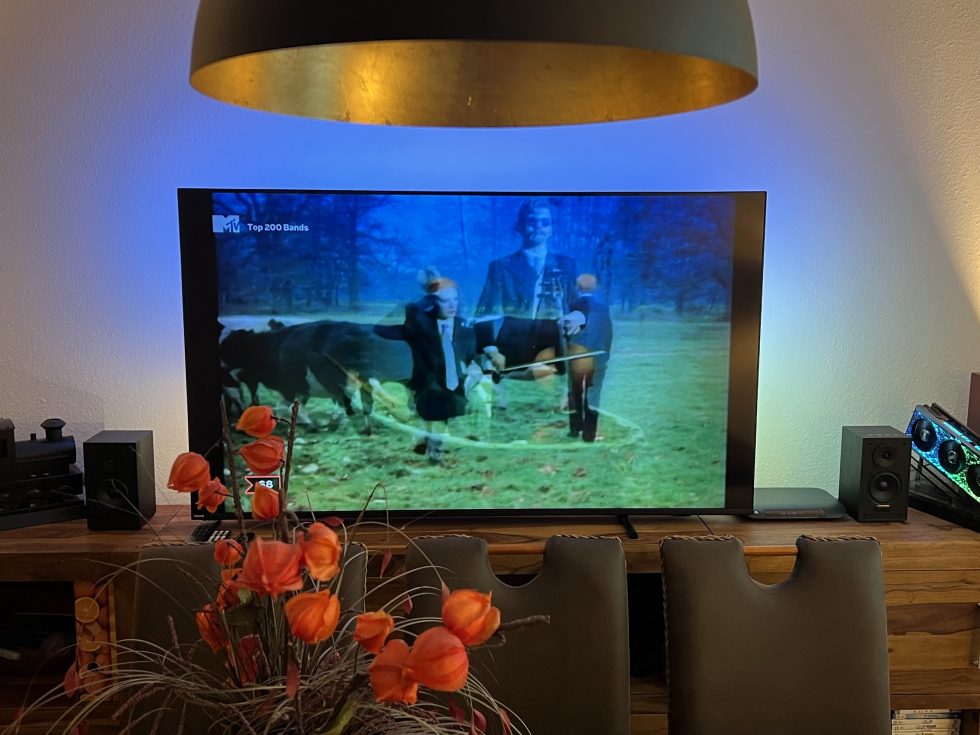Sound check
Let’s finally test subjectively what you can really hear (or not) in the original. I did the test listening in my meeting room, whose solid real wood furniture does not resonate and which has a large carpet and heavy curtains, which dampens the reverb nicely. Where I was sitting, the modes of the subwoofer placed in the corner did not disturb either. Also, the satellites are more at head height while I’m sitting.
Bass reproduction
Which low bass? Edifier specifies the subwoofers with 50 Hz, but you can still hear something up to around 44 Hz. Below that, nothing is audible. A lower-tuned bass guitar is just about reproduced, movie effects can be heard, but not physically felt. From around 48 Hz, however, things really get going. Normal U-music can also be played loudly, and there is absolutely nothing standing in the way of a Helene Fischer party. For the size and the 50 watts, there is still relatively much pressure. That could also be worse.
This range sounds a bit too exaggerated, because the speech fundamental frequency of male vocals falls 100 s to the subwoofer. This gives the whole thing far too much fullness and seems badly exaggerated. In addition, there is a kind of booming, which probably results from the low damping, which is used to keep the sensitivity high. Loud and good at the same time is difficult to realize in this class. The satellites should have been trimmed to 125 Hz lower frequency limit and the subwoofer should have been cut earlier. Technically, this would be possible without any problems with the built-in electronics.
Edifier follows a similar path as with the Spinnaker system, which is extremely boosted at 120 Hz in order to simulate fullness, where the speaker volume already speaks against it. The world champion of sound deceivers is Bose, but that is a completely different topic. In short: Bass is possible, but it could be better and above all more precise. My tip: a small plug in the bass reflex tube grounds the rumble a bit and makes the sub much crisper at the same time, albeit quieter.
Midrange
Female vocals sound much more relaxed than the male ones and therefore much better. It almost becomes delicate and velvety and you can even feel a subjectively perceived warmth, which is not only pleasant, but also contributes to accepting the speakers as they are. Indeed, the midrange drivers do quite a good job.
As long as the condenser blocks the tweeter, the sound continues to go up in a quite relaxed manner. Guitar solos or a finale furioso in a large orchestra are feasible, even in relatively loud. Quiet is also possible, of course. The localization is still quite good, even if the tuning does not allow for an exaggeratedly wide stage. It is and remains a system with compromises. The depth gradation is at least usable, even if not good, which I don’t find disturbing for movies. With music, however, it is. You don’t sit in front of the orchestra, but rather somewhere on top. Locating individual instruments (or sources) is still possible. The stage is also sufficient for gaming and still better than what you usually get as so-called gaming horns in a conservative plastic baroque.
High frequency range
Now the missing crossover becomes painfully noticeable. The midrange is already extremely low in level, while the tweeter, which now starts, cannot fully compensate for this. This is very unfavorable for gaming, where you would like to locate the steps better. A small tip: configurable 2-way crossovers are available in the bookstore for around 5 Euros per channel. And yes, it’s really worth it. You won’t want to miss the new brilliance anymore!
Business as usual. Since the high frequencies are unfortunately also shorted here in the midrange, the level is simply missing at the end and thus also the brilliance. I already wrote something about the conversion. And without? The sibilants sink somewhat into insignificance. Tweeter peaks or too shrill trebles are therefore not an issue, but blowout noises, hissing jazz brooms and other sound highs are badly neglected. Too bad.
Summary
I have a hard time with a general classification, because I am absolutely ambivalent. In my meeting room (about 27 m²) they leave a really useful impression on the TV (optical feed), as long as it’s all about movies or pure entertainment. They are hardly inferior to the much more expensive Edifier A200s installed there. You certainly won’t miss more expensive soundbars, because you can even determine the stereo bandwidth by the distance of the satellites to each other. The fact that you can simply place the subwoofer anywhere in the room wirelessly is a great benefit in this price range.
It gets more difficult with music, because exactly the weaknesses that I already mentioned in the teardown become audible. The huge crossover area between subwoofer and satellites and the missing crossover lead to peaks and losses that I don’t want to have that way. For a birthday party they are still quite suitable, for Auto-Tune “singers” with always the same samples as trivial background music certainly also. But as soon as it becomes a bit more demanding and real vocals or instruments appear, the dilemma begins. This doesn’t mean that a 2.1 setup can’t do the same. But then you have to pay more money. With aptX, even Tidal still sounds quite good in theory of the paid version, but you hardly notice a difference to higher-compressed content or even Spotify in practice. A small tip for those with a software equalizer: lower 125 Hz by about 3 dB, raise 8 KHz by 3 dB and 16 KHz by at least 6 dB.
The tweeter’s weakness due to the missing crossover is amplified by the quite small dispersion angle of the tweeters in the speakers and their textile coverage. This makes the satellites problematic even in the near field on the desk, because you have to tilt them upwards towards your ears. With angled stands, they suddenly sound acceptable again instead of musty. That’s why I wouldn’t recommend them on the desktop without any stand. Without this help, gaming is no fun at all.
But of course, there are also positive sides to this system, because I am always fair. The value for the almost 200 Euros is quite decent. The Edifier M601DB 2.1 system offers a wireless subwoofer, a wide range of connections including Bluetooth 5.1 and aptX, a usable remote control and does without plastic for the body of the respective speakers. Yes, you notice the need to save money in many details, but you don’t see it at first. In the end, it’s another price/performance thing where you can’t really go wrong with not even 200 Euros. You at least get what you pay for, more is apparently not possible. Or is it?
Assuming you do something yourself, there’s still room for improvement. With a little more damping in the satellites (optional) and a configurable 2-way crossover (must) as well as a small plug in the bass reflex tube of the subwoofer (can), you get the acoustic feeling of a 300 euro system for not even 15 euros. With this knowledge, I now send you into the new week with a clear conscience.
The test sample was provided to me by HMC without any preconditions. There was no influence or remuneration, nor was there any obligation to publish.
Edifier M601DB
 | Bestellware - 6-8 Tage Lieferzeit | 178,99 €*Stand: 09.05.24 03:04 |
 | 1-2 Wochen | 199,78 €*Stand: 09.05.24 05:58 |
 | lagernd | 199,80 €*Stand: 09.05.24 05:50 |



































14 Antworten
Kommentar
Lade neue Kommentare
Urgestein
Urgestein
1
Veteran
Urgestein
Mitglied
Urgestein
Urgestein
Veteran
Mitglied
Mitglied
Mitglied
Mitglied
Alle Kommentare lesen unter igor´sLAB Community →